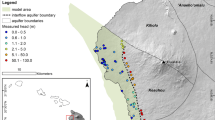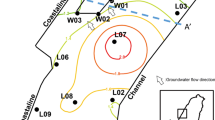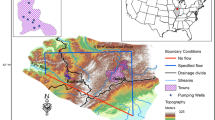Abstract
A numerical groundwater-flow model was used to characterize the source area and volume of Phillips Branch, a baseflow-dominated stream incising a highly permeable unconfined aquifer on the low relief Delmarva Peninsula, USA. Particle-tracking analyses indicate that the source area (5.51 km2) is ∼20% smaller than the topographically defined watershed (6.85 km2), and recharge entering ∼37% of the surface watershed does not discharge to Phillips Branch. Groundwater residence time within the source volume ranges from a few days to almost 100 years, with 95% of the volume “flushing” within 50 years. Artificial discharge from groundwater pumping alters the shape of the source area and reduces baseflow due to the interception of stream flow paths, but has limited impacts on the residence time of groundwater discharged as baseflow. In contrast, artificial recharge from land-based wastewater disposal substantially reduces the source area, lowers the range in residence time due to the elimination of older flow paths to the stream, and leads to increased discharge to adjacent surface-water bodies. This research suggests that, in this and similar hydrogeologic settings, the “watershed” approach to water-resource management may be limited, particularly where anthropogenic stresses alter the transport of soluble contaminants through highly permeable unconfined aquifers.
Résumé
Un modèle numérique d’écoulement souterrain était utilisé pour caractériser le bassin versant d’alimentation du Phillips Branch, un ruisseau généralement peu influencé par lesécoulement superficiel qui recoupe un aquifère libre fortement perméable dans le relief faible de la Péninsule de Delmarva, Etats-Unis. Le suivi des particules indique que la surface d’alimentation (5.51 km²) est inférieure d’environ 20 % à l’aire du bassin versant topographique (6.85 km²), et que environ 37 % du volume de réalimentation du bassin versant superficiel ne se retrouve pas à l’exutoire du Philips Branch. Le temps de séjour souterrain est compris entre quelques jours et 100 ans, avec 95 % du volume total étant « étant évacué » en moins de 50 ans. La décharge par pompage altère la forme du domaine d’écoulement et réduit le débit de base lié à l’interception des chenaux d’écoulement, mais a un impact limité sur les temps de séjour des eaux souterraines alimentant le débit de base. Par contre, la réalimentation artificielle par les installations d’assainissement diminue l’aire d’alimentation, réduit le temps de séjour en évitant les cheminements longs vers le ruisseau, et augmente l’alimentation des masses d’eau superficielles adjacentes. Cette recherche suggère que, dans un contexte hydrogéologique similaire, « l’approche par bassin versant » de la gestion des eaux peut présenter certaines limites, notamment lorsque des contraintes anthropiques modifient le transport de polluants solubles à travers des aquifères libres fortement perméables.
Resumen
Un modelo de flujo numérico de agua subterránea fue usado para caracterizar el área y volúmenes fuente de Phillips Branch, una corriente dominada por flujo base que incisiona un acuífero no confinado altamente permeable en el relieve bajo de la península Delmarva, EEUU. El análisis de seguimiento de partículas indican que el área fuente (5.51 km2) es ∼20% más pequeña que la cuenca definida topográficamente (6.85 km2), y que la recarga entrante que es ∼37% de la superficie de la cuenca no descarga al Phillips Branch. El tiempo de residencia del agua subterránea dentro del volumen de la fuente varía entre pocos días a a casi 100 años, con 95% del volumen “escurrido” en 50 años. La descarga artificial a partir del bombeo del agua subterránea altera la forma del área fuente y reduce el flujo de base debido a la intercepción de las trayectorias del flujo de la corriente, pero tiene impactos limitados en el tiempo de residencia del agua subterránea que descarga como flujo de base. En contraste, la recarga artificial a partir de la disposición de aguas residuales en la tierra reduce sustancialmente el área fuente, disminuye el intervalo del tiempo de residencia debido a la eliminación de viejas trayectorias del flujo hacia la corriente, y conduce una descarga incrementada a cuerpos adyacentes de aguas superficiales. Esta investigación sugiere que, en esta y similares configuraciones hidrogeológicas, el enfoque de la “cuenca de drenaje” para el manejo del recurso agua puede estar limitado, particularmente donde las tensiones antropogénica alteran el transporte de contaminantes solubles a través de acuíferos no confinados altamente permeables.
摘要
应用地下水流动数值模型描述Phillips Branch河源区的面积和体积。该河以基流为主, 切割了美国地势平缓的Delmarva半岛上一个高渗透潜水含水层。质点径迹分析表明, 补给区 (5.51 km2) 较之按地形圈定的流域面积 (6.85 km2) 小 ∼ 20%, 地表流域 ∼37%的补给量未泄入Phillips Branch河。源区地下水滞留时间自几天至接近100年, 95%在50年内。由于阻截了径流路径, 抽取地下水造成的人工排泄改变了补给区的形状, 并使基流量减少, 但是对以基流形式排泄的地下水的驻留时间的影响有限。相反, 由于来自陆地污水处理场的人工补给消除了以前到河流的径流路径, 明显缩小了源区面积, 并减小了驻留时间的变化范围, 导致向邻近地表水体的排泄量增加。该研究表明, 在这种和类似的水文地质背景中, 水资源管理中的流域方法可能是有局限的, 特别是在人类活动改变了强透水潜水含水层中可溶污染物迁移的地区。
Resumo
Foi utilizado um modelo numérico de fluxo de águas subterrâneas para caracterizar a área de origem e o volume de água de Phillips Branch, um ribeiro dominado por fluxo de base incidindo num aquífero livre de elevada permeabilidade nas terras baixas da Península Delmarva, EUA. Análises de rastreio de partículas indicam que a área de origem (5.51 km2) é aproximadamente 20% menor do que a bacia hidrográfica definida topograficamente (6.85 km2), e que a recarga que ocorre em cerca de 37% da superfície da bacia hidrográfica não descarrega para o ribeiro Phillips Branch. O tempo de residência das águas subterrâneas correspondentes aos volumes de descarga no ribeiro varia de poucos dias a quase 100 anos, com 95% do volume de “saídas” a ocorrem no prazo de 50 anos. A descarga artificial efectuada pelo bombeamento das águas subterrâneas modifica a forma da área de origem e reduz o fluxo de base, devido à intercepção das linhas de fluxo do ribeiro, mas tem impacte limitado sobre o tempo de residência das águas subterrâneas descarregadas como fluxo de base. Ao contrário, a recarga artificial por águas residuais reduz substancialmente a área de origem, diminui o intervalo no tempo de residência, devido à eliminação das linhas de fluxo antigas que corriam para o ribeiro, e leva ao aumento da descarga para massas de água superficiais adjacentes. Esta pesquisa sugere que, nas condições hidrogeológicas presentes e similares, a abordagem da “bacia hidrográfica” para a gestão dos recursos hídricos pode ser limitada, especialmente quando as pressões antropogénicas alteram o transporte de contaminantes solúveis em aquíferos não confinados de elevada permeabilidade.






Similar content being viewed by others
References
Anderson MP, Woessner WW (1992) Applied groundwater modeling: simulations of flow and advective transport. Academic, San Diego, CA
Andres AS (1991a) Results of the coastal Sussex County, Delaware, ground-water quality survey. Del Geol Surv Rep of Invest 49, DGS, Newark, DE
Andres AS (1991b) Ground-water level and chemistry data from the coastal Sussex County, Delaware, ground-water quality survey. Del Geol Surv Open File Rep 33, DGS, Newark, DE
Andres AS (1995) Nitrate loss via ground water flow, coastal Sussex County, Delaware. In: Steele K (ed) Animal waste and the land-water interface. CRC, Boca Raton, FL
Andres AS, Klingbeil AD (2006) Thickness and transmissivity of the unconfined aquifer of eastern Sussex County, Delaware. Del Geol Surv Rep of Invest 70, DGS, Newark, DE
Andres AS, Duffy CA, Costas EM (2003) Wellhead protection area delineations for the Lewes-Rehoboth area, Delaware. Del Geol Surv Rep of Invest 65, DGS, Newark, DE
Böhlke JK, Krantz DE (2003) Isotope geochemistry and chronology of offshore ground water beneath Indian River Bay, Delaware. US Geol Surv Water Resour Invest Rep 03-4192
Cambareri TC, Eichner EM (1998) Watershed delineation and ground water discharge to a coastal embayment. Ground Water 36(4):626–634
Denver JM (1989) Effects of agricultural practices and septic-system effluent on the quality of water in the unconfined aquifer in parts of eastern Sussex County, Delaware. Del Geol Surv Rep of Invest 45, DGS, Newark, DE
Denver JM (1993) Herbicides in shallow ground water at two agricultural sites in Delaware. Del Geol Surv Rep of Invest 51, DGS, Newark, DE
Denver JM, Sandstrom MW (1991) Distribution of atrazine and two metabolites in the unconfined aquifer, southeastern Delaware. In: Mallard GE, Aronson DA (eds) US Geological Survey Toxic Substances Hydrology Program, Proceedings of the technical meeting, Monterey, CA, 11–15 March 1991. US Geol Surv Water Resour Invest Rep 91-4034
DGS (2009) Recent and historical ground water level data. Delaware Geological Survey, University of Delaware, Newark, DE. http://www.dgs.udel.edu/Hydrology/HydroResources/GroundWaterData.aspx. Cited 1 June 2009
DNREC (1998) Total maximum daily loads (TMDLs) for Indian River, Indian River Bay, and Rehoboth Bay, Delaware. Secretary’s Order No. 98-W-0044, Department of Natural Resources and Environmental Control, Dover, DE
Dunkle SA, Plummer LN, Busenberg E, Phillips PJ, Denver JM, Hamilton PA, Michel RL, Coplen TB (1993) Chlorofluorocarbons (CCl3F and CCl2F2) as dating tools and hydrologic tracers in shallow groundwater of the Delmarva Peninsula, Atlantic Coastal Plain, United States. Water Resour Res 29(12):3837–3860
Harbaugh AW (1990) A computer program for calculating subregional water budgets using results from the U.S. Geological Survey modular three-dimensional finite-difference ground-water flow model. US Geol Surv Open File Rep 90-392
Harbaugh AW, Banta ER, Hill MC, McDonald MG (2000) MODFLOW-2000, the U.S. Geological Survey modular ground-water model: user guide to modularization concepts and the ground-water flow process. US Geol Surv Open File Rep 00-92
Johnston RH (1973) Hydrology of the Columbia (Pleistocene) deposits of Delaware: an appraisal of a regional water-table aquifer. Del Geol Surv Bull 14, DGS, Newark, DE
Johnston RH (1976) Relation of ground water to surface water in four small basins of the Delaware Coastal Plain. Del Geol Surv Rep of Invest 24, DGS, Newark, DE
Johnston RH (1977) Digital model of the unconfined aquifer in central and southeastern Delaware. Del Geol Surv Bull 15, DGS, Newark, DE
Kasper JW (2006) Simulated ground-water flow at the Fairmount site, Sussex County, DE (USA), with implications for nitrate transport. MSc Thesis, University of Delaware, USA
McKenna TE, Andres AS, Lepp KP (2007) Digital watershed and bay boundaries for Rehoboth Bay, Indian River Bay, and Indian River. Del Geol Surv Open File Rep 47, DGS, Newark, DE
Modica E, Reilly TE, Pollock DW (1997) Patterns and age distribution of ground-water flow to streams. Ground Water 35(3):523–537
Modica E, Buxton HT, Plummer LN (1998) Evaluating the source and residence times of groundwater seepage to streams, New Jersey Coastal Plain. Water Resour Res 34(11):2797–2810
NOAA (2010) Tidal station locations and ranges. National Oceanic and Atmospheric Administration, Washington, DC. http://tidesandcurrents.noaa.gov/tides07/tab2ec2b.html#41. Cited 19 May 2010
NRC (2000) Clean coastal waters: understanding and reducing the effects of nutrient pollution. National Research Council, National Academy Press, Washington, DC
Parkhurst DL, Plummer LN (1993) Geochemical models. In: Alley WM (ed) Regional ground-water quality. Reinhold, New York
Pint CD, Hunt RJ, Anderson MP (2003) Flowpath delineation and ground water age, Allequash Basin, Wisconsin. Ground Water 41(7):895–901
Plummer LN, Dunkle SA, Busenberg E (1993) Data on chlorofluorocarbons (CCl3F and CCl2F2) as dating tools and hydrologic tracers in shallow ground water of the Delmarva Peninsula: data tabulation. US Geol Surv Open File Rep 93-484
Pollock DW (1989) Documentation of computer programs to compute and display pathlines using results from the U.S. Geological Survey modular three-dimensional finite-difference ground-water flow model. US Geol Surv Open File Rep 89-381
Pollock DW (1994) User’s guide for MODPATH/MODPATH-PLOT, version 3: a particle tracking post-processing package for MODFLOW, the U.S. Geological Survey finite-difference ground-water flow model. US Geol Surv Open File Rep 94-464
Ramsey KW (2003) Geologic map of the Lewes and Cape Henlopen quadrangles, Delaware. Del Geol Surv Geol Map Ser 12, DGS, Newark, DE
Reilly TE (2001) System and boundary conceptualization in ground-water flow simulation. US Geol Surv Tech Water Resour Invest Book 3, Chap. B8, US Geological Survey, Reston, VA
Robinson MA, Reay WG (2002) Ground water flow analysis of a mid-Atlantic outer Coastal Plain watershed, Virginia, U.S.A. Ground Water 40(2):123–131
Shedlock RJ, Hamilton PA, Denver JM, Phillips PJ (1993) Multiscale approach to regional ground-water-quality assessment of the Delmarva Peninsula. In: Alley WM (ed) Regional ground-water quality. Reinhold, New York
Shedlock RJ, Denver JM, Hayes MA, Hamilton PA, Koterba MT, Bachman LJ, Phillips PJ, Banks WSL (1999) Water-quality assessment of the Delmarva Peninsula, Delaware, Maryland, and Virginia: results of investigations, 1987-91. US Geol Surv Water Suppl Pap 2355-A
SpatLab (2005) Delaware 30-meter DEM’s composited by county. Spatial Analysis Lab, College of Agriculture and Natural Resources, University of Delaware, Newark, DE. http://www.udel.edu/FREC/spatlab/dems/co_dems.html. Cited 20 June 2005
Tóth J (1962) A theory of groundwater motion in small drainage basins in central Alberta, Canada. J Geophys Res 67(11):4375–4387
Tóth J (1963) A theoretical analysis of groundwater flow in small drainage basins. J Geophys Res 68(16):4795–4812
USEPA (2008) Handbook for developing watershed plans to restore and protect our waters. US Environ Protection Agency Doc EPA 841-B-08-002, US EPA, Washington, DC
USGS (1998a) 1:24,000-scale digital line graph, Fairmount Quadrangle. US Geological Survey, Reston, VA
USGS (1998b) 1:24,000-scale digital line graph, Harbeson Quadrangle. US Geological Survey, Reston, VA
USGS (1998c) 1:24,000-scale digital line graph, Millsboro Quadrangle. US Geological Survey, Reston, VA
USGS (1998d) 1:24,000-scale digital line graph, Frankford Quadrangle. US Geological Survey, Reston, VA
Walter DA, Masterson JP, Hess KM (2004) Ground-water recharge areas and traveltimes to pumped wells, ponds, streams, and coastal water bodies, Cape Cod, Massachusetts. US Geol Surv Sci Invest Map I-2857
Wheeler JC (2003) Freshwater use in Delaware, 2000. US Geol Survey Fact Sheet 111-03
WHI (2003) Visual MODFLOW v.3.1 user’s manual. Waterloo Hydrogeologic, Waterloo, ON, Canada
Winter TC (2001) The concept of hydrologic landscapes. J Am Water Resour Assoc 37(2):335–349
Winter TC, Rosenberry DO, LaBaugh JW (2003) Where does ground water in small watersheds come from? Ground Water 41(7):989–1000
Zlotnik V (1994) Interpretation of slug and packer tests in anisotropic aquifers. Ground Water 32(5):761–766
Acknowledgements
The authors acknowledge the Delaware Department of Natural Resources and Environmental Control (DNREC), Delaware Geological Survey (DGS), US Geological Survey (USGS), and Department of Geological Sciences at the University of Delaware for providing data and financial and in kind support to J.W. Kasper, while a graduate student. A.S. Andres (DGS), S.W. Ator (USGS), and S.C. Cooper (USGS) are gratefully acknowledged for reviewing the draft manuscript and providing valuable suggestions for its improvement. Two anonymous reviewers provided constructive comments that greatly improved the final manuscript.
Author information
Authors and Affiliations
Corresponding author
Rights and permissions
About this article
Cite this article
Kasper, J.W., Denver, J.M., McKenna, T.E. et al. Simulated impacts of artificial groundwater recharge and discharge on the source area and source volume of an Atlantic Coastal Plain stream, Delaware, USA. Hydrogeol J 18, 1855–1866 (2010). https://doi.org/10.1007/s10040-010-0641-x
Received:
Accepted:
Published:
Issue Date:
DOI: https://doi.org/10.1007/s10040-010-0641-x




